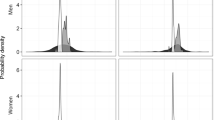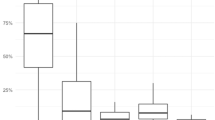Abstract
Personal activity patterns have often been suggested as a source of unexplained variability when comparing personal particulate matter (PM2.5) exposure to modeled data using central site or microenvironmental data. To characterize the effect of personal activity patterns on asthmatic children’s personal PM2.5 exposure, data from the Windsor, Ontario Exposure Assessment Study were analyzed. The children spent on an average 67.1±12.7% (winter) and 72.3±22.6% (summer) of their time indoors at home where they received 51.7±14.8% and 66.3±19.0% of their PM2.5 exposure, respectively. In winter, 17.7±5.9% of their time was spent at school where they received 38.6±11.7% of their PM2.5 exposure. In summer, they spent 10.3±11.8% ‘indoors away from home’, which represented 23.4±18.3% of their PM2.5 exposure. Personal activity codes adapted from those of the National Human Activity Pattern Survey and the Canadian Human Activity Pattern Survey were assigned to the children’s activities. Of the over 100 available activity codes, 19 activities collectively encompassed nearly 95% of their time. Generalized estimating equation (GEE) models found that, while indoors at home, relative to daytime periods when sedentary activities were conducted, several personal activities were associated with significantly elevated personal PM2.5 exposures. Indoor playing represented a mean increase in PM2.5 of 10.1 μg/m3 (95% CI 6.3–13.8) and 11.6 μg/m3 (95% CI 8.1–15.1) in winter and summer, respectively, as estimated by a personal nephelometer.
This is a preview of subscription content, access via your institution
Access options
Subscribe to this journal
Receive 6 print issues and online access
$259.00 per year
only $43.17 per issue
Buy this article
- Purchase on Springer Link
- Instant access to full article PDF
Prices may be subject to local taxes which are calculated during checkout


Similar content being viewed by others
References
McConnell R, Islam T, Shankardass K, Jerrett M, Lurmann F, Gilliland F et al. Childhood incident asthma and traffic-related air pollution at home and school. Environ Health Perspect 2010; 118: 1021–1026.
Delfino RJ, Zeiger RS, Seltzer JM, Street DH . Symptoms in pediatric asthmatics and air pollution: differences in effects by symptom severity, anti-inflammatory medication use and particulate averaging time. Environ Health Perspect 1998; 106: 751–761.
Slaughter JC, Lumley T, Sheppard L, Koenig JQ, Shapiro GG . Effects of ambient air pollution on symptom severity and medication use in children with asthma. Annal Allergy Asthma Immunol 2003; 91: 346–353.
Li S, Batterman S, Wasilevich E, Wahl R, Wirth J, Su F-C et al. Association of daily asthma emergency department visits and hospital admissions with ambient air pollutants among the pediatric Medicaid population in Detroit: Time-series and time-stratified case-crossover analyses with threshold effects. Environ Res 2011; 111: 1137–1147.
Norris G, YoungPong SN, Koenig JQ, Larson TV, Sheppard L, Stout JW . An Association between fine particles and Asthma Emergency Department visits for children in Seattle. Environ Health Perspect 1999; 107: 489–493.
Strickland MJ, Darrow LA, Klein M, Flanders WD, Sarnat JA, Waller LA et al. Short-term associations between ambient air pollutants and pediatric asthma emergency department visits. Am J Respir Crit Care Med 2010; 182: 307–316.
Gauderman WJ, Avol E, Gilliland F, Vora H, Thomas D, Berhane K et al. The effect of air pollution on lung development from 10 to 18 years of age. N Engl J Med 2004; 351: 1057–1067.
He Q-Q, Wong TW, Du L, Jiang Z-Q, Gao Y, Qiu H et al. Effects of ambient air pollution on lung function growth in Chinese schoolchildren. Respir Med 2010; 104: 1512–1520.
Kulkarni N, Grigg J . Effect of air pollution on children. Paediatr Child Health 2008; 18: 238–243.
O'Connor GT, Neas L, Vaughn B, Kattan M, Mitchell H, Crain EF et al. Acute respiratory health effects of air pollution on children with asthma in US inner cities. J Allergy Clin Immunol 2008; 121: 1133–1139 e1131.
Marty MA, Blaisdell RJ, Broadwin R, Hill M, Shimer D, Jenkins M . Distribution of daily breathing rates for use in California's Air Toxics Hot Spots Program risk assessments. Hum Ecol Risk Assessment 2002; 8: 1723–1737.
Kelly FJ . Oxidative stress: its role in air pollution and adverse health effects. Occup Environ Med 2003; 60: 612–616.
Dales R, Wheeler AJ, Mahmud M, Frescura AM, Liu L . The influence of neighborhood roadways on respiratory symptoms among elementary schoolchildren. J Occup Environ Med 2009; 51: 654–660.
Dockery DW . Epidemiologic evidence of cardiovascular effects of particulate air pollution. Environ Health Perspect 2001; 109 (Suppl 4): 483–486.
Adgate JL, Ramachandran G, Pratt GC, Waller LA, Sexton K . Longitudinal variability in outdoor, indoor, and personal PM2.5 exposure in healthy non-smoking adults. Atmos Environ 2003; 37: 993.
Brown KW, Sarnat JA, Suh HH, Coull BA, Koutrakis P . Factors influencing relationships between personal and ambient concentrations of gaseous and particulate pollutants. Thematic Issue BioMicroWorld Conference 2009; 407: 3754–3765.
Crist KC, Liu B, Kim M, Deshpande SR, John K . Characterization of fine particulate matter in Ohio: Indoor, outdoor, and personal exposures. Environ Res 2008; 106 (1): 62–71.
Wallace L . Correlations of personal exposure to particles with outdoor air measurements: a review of recent studies. Aerosol Sci Tech 2000; 32: 15–25.
Liu LJ, Box M, Kalman D, Kaufman J, Koenig J, Larson T et al. Exposure assessment of particulate matter for susceptible populations in Seattle. Environ Health Perspect 2003; 111: 909–918.
Ozkaynak H, Xue J, Spengler J, Wallace L, Pellizzari E, Jenkins P . Personal exposure to airborne particles and metals: results from the Particle TEAM study in Riverside, California. J Expo Anal Environ Epidemiol 1996; 6: 57–78.
Wu C-F, Delfino RJ, Floro JN, Quintana PJE, Samimi BS, Kleinman MT et al. Exposure assessment and modeling of particulate matter for asthmatic children using personal nephelometers. Atmos Environ 2005; 39: 3457–3469.
Yip FY, Keeler GJ, Dvonch JT, Robins TG, Parker EA, Israel BA et al. Personal exposures to particulate matter among children with asthma in Detroit, Michigan. Particulate Matter: Atmospheric Sciences, Exposure and the Fourth Colloquium on PM and Human Health - Papers from the AAAR PM Meeting 2004; 38: 5227–5236.
Wallace LA, Wheeler AJ, Kearney J, Van Ryswyk K, You H, Kulka RH et al. Validation of continuous particle monitors for personal, indoor, and outdoor exposures. J Expo Sci Environ Epidemiol 2011; 21: 49–64.
Wheeler AJ, Xu X, Kulka R, You H, Wallace L, Mallach G et al. Windsor, Ontario exposure assessment study: design and methods validation of personal, indoor, and outdoor air pollution monitoring. J Air Waste Manag Assoc 2011(a); 61: 324–338.
Klepeis NE, Nelson WC, Ott WR, Robinson JP, Tsang AM, Switzer P et al. The National Human Activity Pattern Survey (NHAPS): a resource for assessing exposure to environmental pollutants. J Expo Anal Environ Epidemiol 2001; 11: 231–252.
Leech JA, Wilby K, McMullen E, Laporte K . The Canadian human activity pattern survey: report of methods and population surveyed. Chronic Dis Can 1996; 17: 118–123.
Quintana PJ, Valenzia JR, Delfino RJ, Liu LJ . Monitoring of 1-min personal particulate matter exposures in relation to voice-recorded time-activity data. Environ Res 2001; 87: 199–213.
Wallace LA, Mitchell H, O'Connor GT, Neas L, Lippmann M, Kattan M et al. Particle concentrations in inner-city homes of children with asthma: the effect of smoking, cooking, and outdoor pollution. Environ Health Perspect 2003; 111: 1265–1272.
Wallace L, Williams R, Rea A, Croghan C . Continuous weeklong measurements of personal exposures and indoor concentrations of fine particles for 37 health-impaired North Carolina residents for up to four seasons. Atmos Environ 2006; 40: 399–414.
Görner P, Bemer D, Fabriés JF . Photometer measurement of polydisperse aerosols. J Aerosol Sci 1995; 26: 1281–1302.
Leech JA, Nelson WC, Burnett RT, Aaron S, Raizenne ME . It's about time: A comparison of Canadian and American time-activity patterns[dagger]. J Expo Anal Environ Epidemiol 2002; 12: 427–432.
Noullett M, Jackson PL, Brauer M . Winter measurements of children's personal exposure and ambient fine particle mass, sulphate and light absorbing components in a northern community. Atmos Environ 2006; 40: 1971–1990.
Wheeler AJ, Wallace L, Kearney J, Van Ryswyk K, You H, Kulka R et al. Personal, indoor, and outdoor concentrations of fine and ultrafine particles using continuous monitors in multiple residences. Aerosol Sci Technol 2011(b); 45: 1078–1089.
MacNeill M, Wallace L, Kearney J, Allen RW, Van Ryswyk K, Judek S et al. Factors influencing variability in the infiltration of PM2.5 mass and its components. Atmos Environ 2012; 61: 518–532.
Allen R, Wallace L, Larson T, Sheppard L, Liu LJ . Estimated hourly personal exposures to ambient and nonambient particulate matter among sensitive populations in Seattle, Washington. J Air Waste Manag Assoc 2004; 54: 1197–1211.
Elgethun K, Yost MG, Fitzpatrick CT, Nyerges TL, Fenske RA . Comparison of global positioning system (GPS) tracking and parent-report diaries to characterize children's time-location patterns. J Expo Sci Environ Epidemiol 2007; 17: 196–206.
Bellemans T, Kochan B, Janssens D, Wets G, Timmermans H . Field evaluation of personal digital assistant enabled by global positioning system: impact on quality of activity and diary data. Transport Res Rec 2008; 2049: 136–143.
Acknowledgements
We would like to thank the study participants, the field technicians, and Nina Dobbin (Clark) and Morgan MacNeill for conducting the internal review. Funding for this work was provided by the Border Air Quality Strategy.
Author information
Authors and Affiliations
Corresponding author
Ethics declarations
Competing interests
The authors declare no conflict of interest.
Rights and permissions
About this article
Cite this article
Van Ryswyk, K., Wheeler, A., Wallace, L. et al. Impact of microenvironments and personal activities on personal PM2.5 exposures among asthmatic children. J Expo Sci Environ Epidemiol 24, 260–268 (2014). https://doi.org/10.1038/jes.2013.20
Received:
Revised:
Accepted:
Published:
Issue Date:
DOI: https://doi.org/10.1038/jes.2013.20
Keywords
This article is cited by
-
Electric vehicle fleet penetration helps address inequalities in air quality and improves environmental justice
Communications Earth & Environment (2023)
-
Risk assessment of particulate matter by considering time-activity-pattern and major microenvironments for preschool children living in Seoul, South Korea
Environmental Science and Pollution Research (2021)
-
A framework for estimating the US mortality burden of fine particulate matter exposure attributable to indoor and outdoor microenvironments
Journal of Exposure Science & Environmental Epidemiology (2020)
-
Dynamic classification of personal microenvironments using a suite of wearable, low-cost sensors
Journal of Exposure Science & Environmental Epidemiology (2020)
-
Comparison of particulate matter exposure estimates in young children from personal sampling equipment and a robotic sampler
Journal of Exposure Science & Environmental Epidemiology (2017)



